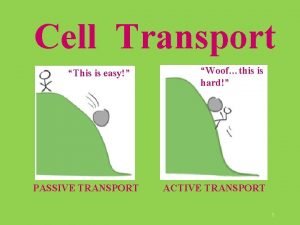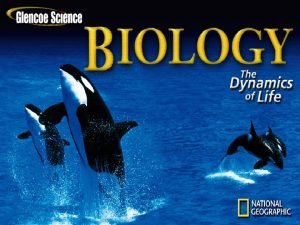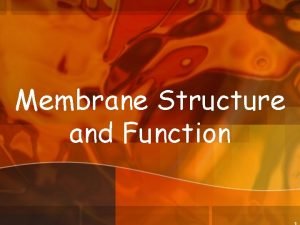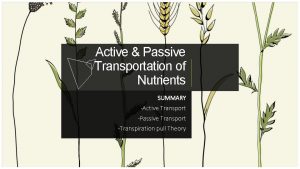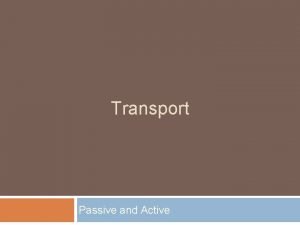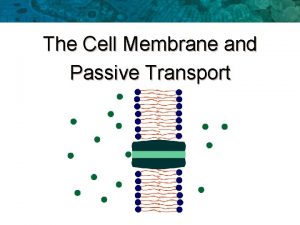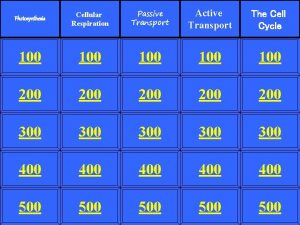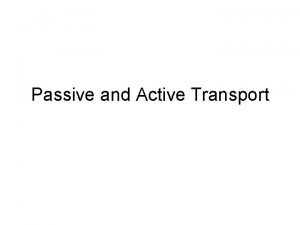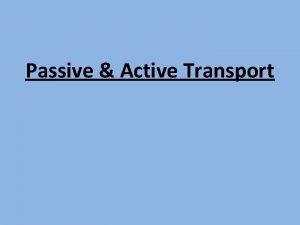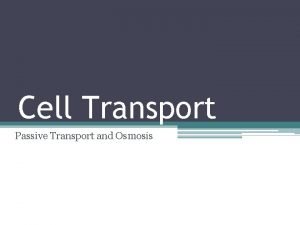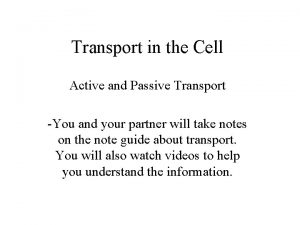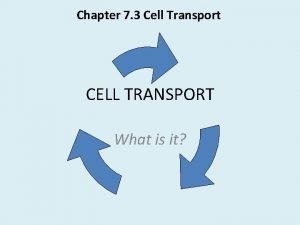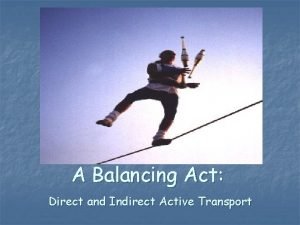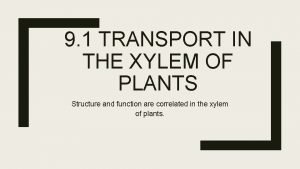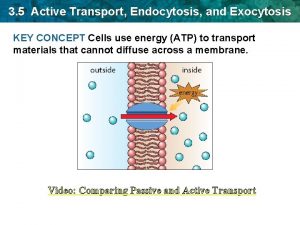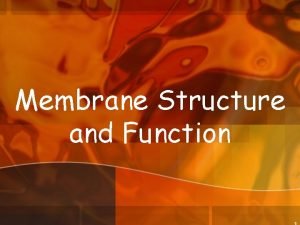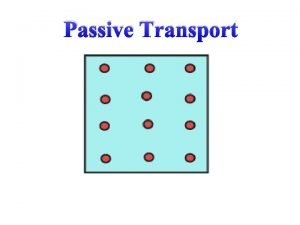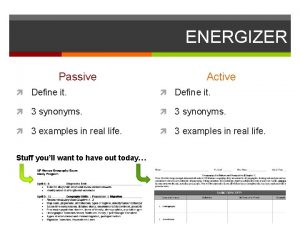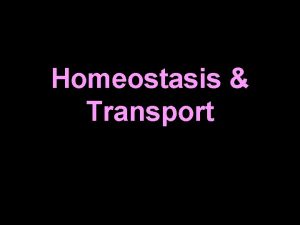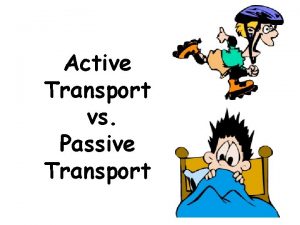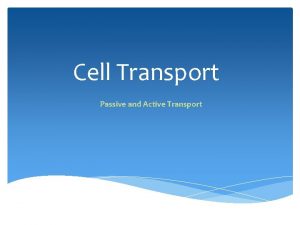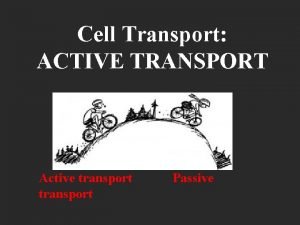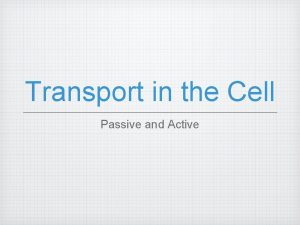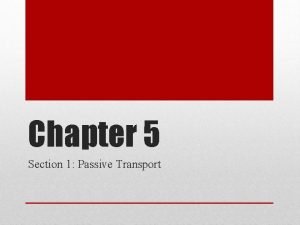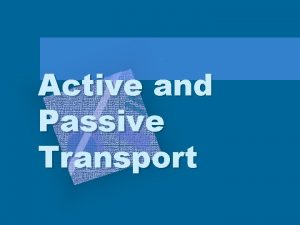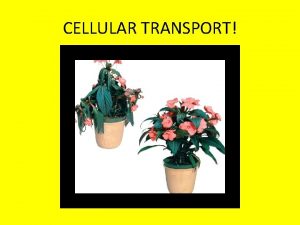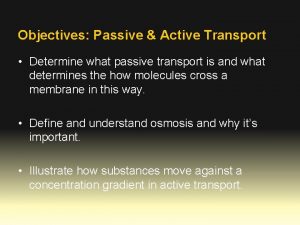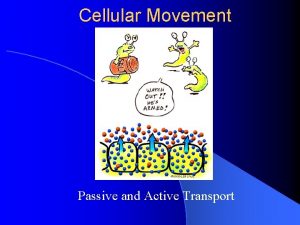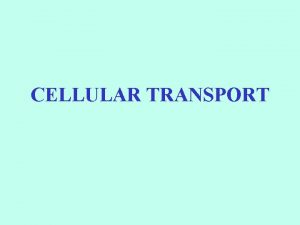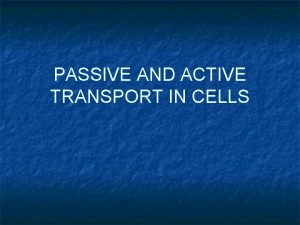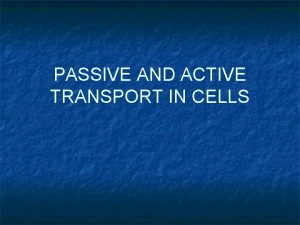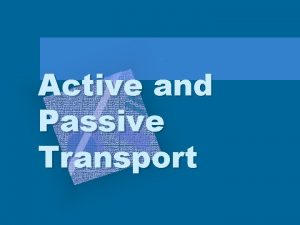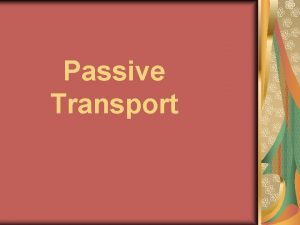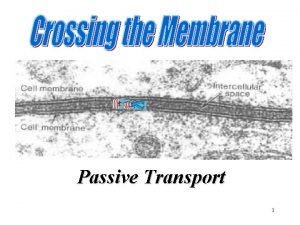Cell Transport This is easy PASSIVE TRANSPORT Woofthis































- Slides: 31

Cell Transport “This is easy!” PASSIVE TRANSPORT “Woof…this is hard!” ACTIVE TRANSPORT 1

Cell Transport • Two types of transport: 1. Passive Transport Diffusion Facilitated Diffusion Osmosis 2. Active Transport Endocytosis Exocytosis 2

Refresher… • Remember that… – A solute is… ‘stuff’ being dissolved (sugar) • An example is…. ? – A solvent is… doing the dissolving (water) • An example is…? 3

Passive Transport • Molecules move from a high concentration to a low concentration • Molecules move “down” the concentration gradient – What is a concentration gradient and what does this mean? • A concentration gradient is the process of solutes moving through a solution or gas from an area of higher particles to an area with low particles or vice versa. • Usually, the two areas are separated by the cell membrane. • Does NOT use energy (ATP) 4

Diffusion • Movement from high concentration low concentration • No ATP used • Can occur in non-living systems (for ex: dye, hairspray…) 5

6

Facilitated Diffusion • Movement from high concentration low concentration – No ATP used – Speeds up the process – Proteins CAN change SHAPE 7

Facilitated Diffusion • Does NOT use energy so it must be a type of passive transport! • Moves things from high to low concentrations • Remember, “facilitate” means to “help” or “make easier” 8

Let’s Test Diffusion! 9

What did we see…!? Why? ! The OUTSIDE OF THE BAGGIE turns BLUE, because the iodine is small enough to diffuse into the “starch bag, ” but the starch is too big to diffuse out! the iodine positively indicates for the starch! 10

Osmosis • Osmosis: – diffusion of water across a membrane • Water moves across a semipermeable membrane from an area of high water concentration to an area of low water concentration • If water can cross a membrane, but the solute cannot, then… – The water moves towards the side with MORE solute to balance the concentrations 11

Osmosis 12

O S M O S I S 13

14

• One big difference between osmosis and diffusion is that both solvent and solute particles are free to move in diffusion, but when we talk about osmosis, only the solvent molecules (water molecules) cross the membrane 15

Osmoregulation • Osmoregulation – control of water balance • Turgor pressure – pressure inside a cell • Tonicity – tendency of a cell to lose or gain water based on the solution it is in • 3 Types of solutions: – Isotonic – Hypertonic 16

Cell in Isotonic Solutions • Solution has same concentration of dissolved particles as the cell • Water moves into and out of cell at equal rates and cell size remains constant • Cell does not change shape 17

Cell in a Hypotonic Solutions • Solution has a lower concentration of dissolved particles than the cell – Water flows INTO the cell – The cell swells/gets big! – Ex. Happens with distilled water • Animals: • Cytolysis (when a cell BURSTS!) 18

Cell in a Hypertonic Solutions • Solution has a higher concentration of dissolved particles than the cell – Water flows OUT of the cell – The cell shrivels up and turgor pressure decreases – Ex. Salt water (ocean!) Na. Cl The water will move out of the fish towards the area with MORE solutes (ocean) to balance the concentrations! Poor fish… 19

20

Let’s Practice! **Remember, tonicity is relative to the solution** Always read the question thoroughly!! Water will leave the cell 90% Solute (salt)_______ 10% Solute (salt)_______ Hypertonic Solution is…. _________ Move out & will SHRINK Water is going to… _________ 21

Let’s Practice! Water will enter the cell 0% Solute (salt)_______ 10% Solute (salt)_______ Hypotonic Solution is…. _________ Move in & will SWELL Water is going to… _________ 22

Let’s Practice! Water will leave the cell 25% Solute (salt)_______ 15% Solute (salt)_______ Hypertonic Solution is…. _________ Move out & will SHRINK Water is going to… _________ 23

Let’s Practice! Water will enter and leave the cell at equal 35% Solute (salt)_______ rates! 35% Solute (salt)_______ Isotonic Solution is…. _________ STAY THE SAME! Water is going to… _________ 24

https: //www. youtube. com/watch? v=6 MWl 3 DCa 2 u. M 25

ACTIVE TRANSPORT 26

Remember…. • Passive Transport does NOT require energy • Types of passive transport: • Diffusion • Facilitated Diffusion • Osmosis 27

Active Transport • Requires energy! • Molecules move against their concentration gradients (from LOW concentration to HIGH) • Cells use energy to power this process • Two types: Endocytosis and Exocytosis 28

Exocytosis • USES ENERGY! • Moves “BIG” materials OUT of the cell • Vesicle moves to the plasma membrane and fuses with it, contents are emptied from the cell 29

Endocytosis • USES Energy! • Brings “BIG” materials INTO the cell • Three types, one major type: – Phagocytosis – “cell eating”, engulfs food and forms a vesicle around it; fuses with lysosomes and uses the contents 30

Additional Notes T- CHART Passive Transport 1. NO ENERGY NEEDED 2. THREE SUB UNITS - Osmosis - Diffusion - Facilitated Diffusion 3. HIGH to LOW (down the concentration gradient) 4. SMALL MOLECULES Active Transport 1. YES! ENERGY NEEDED 2. TWO SUB UNITS - Exocytosis - Endocytosis 3. LOW to HIGH (against the concentration gradient) 4. BIG MOLECULES 31
 Passive transport vs active transport venn diagram
Passive transport vs active transport venn diagram Passive transport vs active transport venn diagram
Passive transport vs active transport venn diagram Unlike passive transport active transport requires
Unlike passive transport active transport requires Active and passive transport
Active and passive transport Inductive and deductive reasoning geometry examples
Inductive and deductive reasoning geometry examples Deductive method
Deductive method Deductive reasoning
Deductive reasoning 3 passive transport
3 passive transport Symport
Symport Active transport
Active transport Primary active transport vs secondary active transport
Primary active transport vs secondary active transport Bioflix activity membrane transport active transport
Bioflix activity membrane transport active transport Bioflix membrane transport
Bioflix membrane transport Passive vs active transport
Passive vs active transport Passive transport ex
Passive transport ex Tonicity of plasma
Tonicity of plasma Active and passive transport
Active and passive transport Is contractile vacuole active or passive
Is contractile vacuole active or passive Concentration cells
Concentration cells Is photosynthesis active or passive transport
Is photosynthesis active or passive transport Active transport
Active transport Cell transport cartoon
Cell transport cartoon Flaccid vs plasmolysed
Flaccid vs plasmolysed Passive transport brainpop
Passive transport brainpop Active or passive transport
Active or passive transport Exocytosis active or passive transport
Exocytosis active or passive transport Passive transport defintion
Passive transport defintion Xylem passive transport
Xylem passive transport Exocytosis active transport
Exocytosis active transport Difference of active and passive transport
Difference of active and passive transport Passive transport definition
Passive transport definition Passive transport synonym
Passive transport synonym







